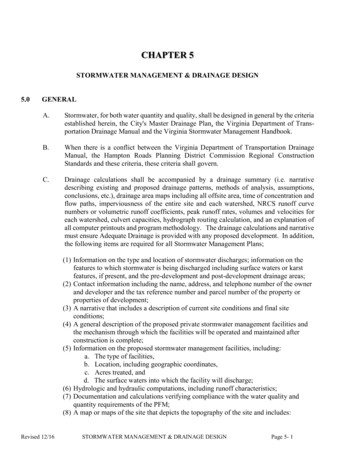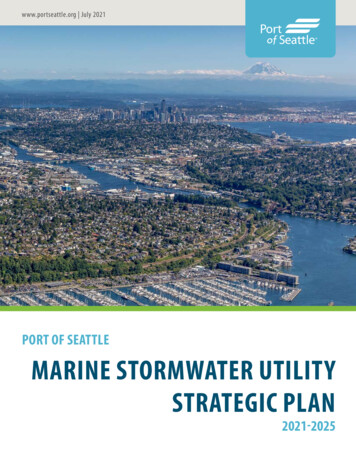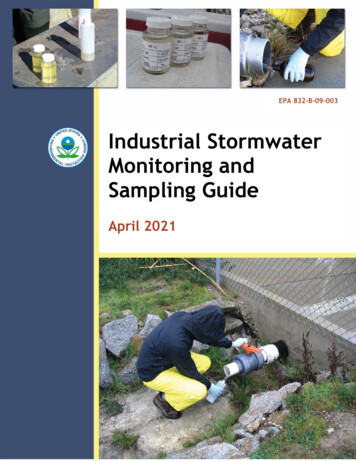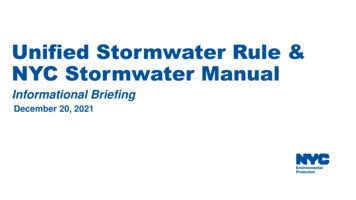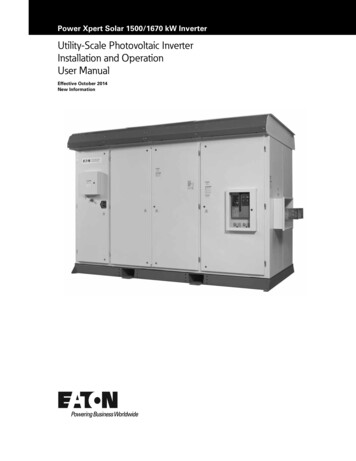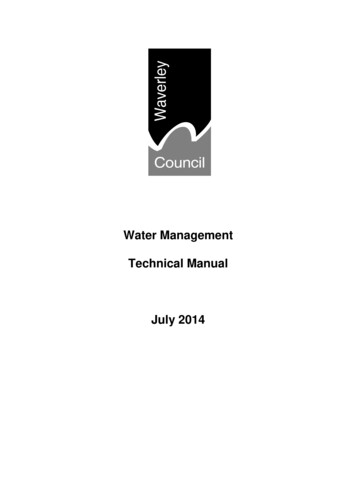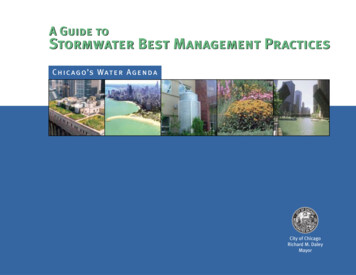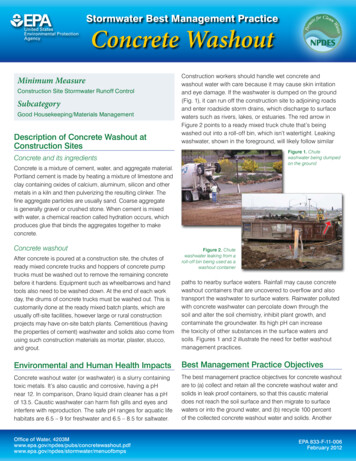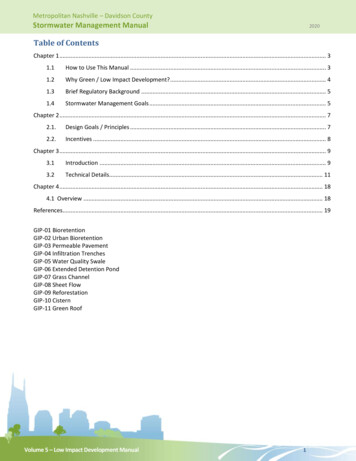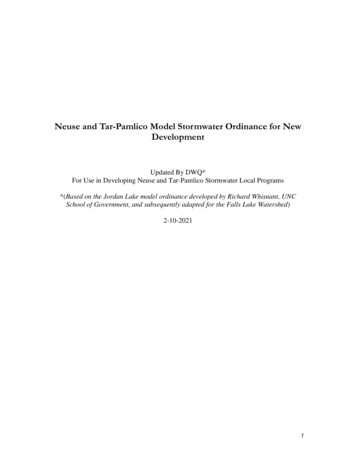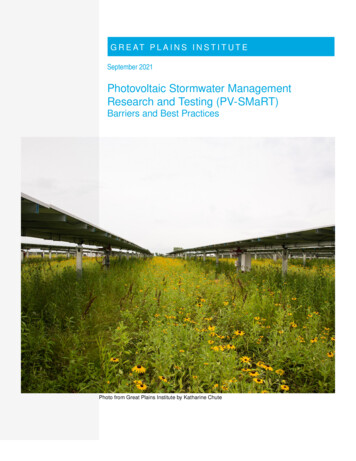
Transcription
sG R E AT P L A I N S I N S T I T U T ESeptember 2021Photovoltaic Stormwater ManagementResearch and Testing (PV-SMaRT)Barriers and Best PracticesPhoto from Great Plains Institute by Katharine Chute
AcknowledgmentsPV-SMaRT Project Team Aaron Hanson, University of Minnesota Brian Ross, Great Plains Institute David Mulla, University of Minnesota Jennifer Daw, National Renewable Energy Laboratory Megan Day, National Renewable Energy Laboratory Rob Davis, Fresh EnergyWater Quality Task Force Members Andrew Nelson, Westwood Professional Services Britta Hansen, Emmons Olivier Resources Dave Gasper, New York Department of Environmental Resources David Morley, American Planning Association Gavin Chase Meinschein, Engie North America Greg Hoffman, Center for Watershed Protection Jake Janski, Minnesota Native Landscapes Jason Bernagros, US Environmental Protection Agency Office of Research and Development Peter Parkinson, AES Distributed Energy Robert Goo, US Environmental Protection Agency Office of Wetlands, Oceans, and Watersheds Seth Brown, National Municipal Stormwater Association Sybil Sharvelle, Colorado State InTERFEWS Director Veronica Craw, Georgia Department of Natural ResourcesAdditional comments were provided from regulators and stakeholders in non-case study states.DisclaimerThis material is based on work supported by the US Department of Energy Office of Energy Efficiencyand Renewable Energy under the Solar Energy Technologies Office Award Number DE-AC3608GO28308 .This report was prepared as an account of work sponsored by an agency of the United StatesGovernment. Neither the United States Government nor any agency thereof, nor any of theiremployees, makes any warranty, express or implied, or assumes any legal liability or responsibilityfor the accuracy, completeness, or usefulness of any information, apparatus, product, or processdisclosed, or represents that its use would not infringe privately owned rights. Reference herein toany specific commercial product, process, or service by trade name, trademark, manufacturer, orotherwise does not necessarily constitute or imply its endorsement, recommendation, or favoring bythe United States Government or any agency thereof. The views and opinions of authors expressedherein do not necessarily state or reflect those of the United States Government or any agencythereof.
PV-SMaRT Barriers and Best PracticesAbout the PV-SMaRT ProjectThe Photovoltaic Stormwater Management Research and Testing (PV-SMaRT) project seeks todevelop and disseminate research-based, solar-specific resources for estimating stormwaterrunoff at ground-mounted PV facilities as well as stormwater management and water qualitypermitting best practices. The Great Plains Institute (GPI) identified existing permitting practicesand standards for solar development in the five PV-SMaRT case study states (New York,Georgia, Minnesota, Colorado, and Oregon) and other states across the nation. From thisassessment GPI completed the Potential Stormwater Barriers and Opportunities document.The Barriers and Opportunities document is the foundation for this document, which identifiespermitting best practices and solar project best management practices. The Best Practicesdocument identifies practices to reduce barriers and realize opportunities for a transparent andpredictable permitting process for large scale solar development that also improves waterquality and stormwater management outcomes.The Best Practices document is a final draft for public use and review. It will be modified toreference additional technical information (validated modeling results, lookup tables for runoffcoefficients) in the next phase of the project. Users are invited to provide comments andsuggest changes for the next phase.IntroductionStormwater permitting standards are designed to protect surface and ground waters from theeffects of land development or redevelopment. These land use changes typically modifystormwater flow, infiltration, evapotranspiration, and pollutant loading from what occurs in anundeveloped or natural landscape. Removing native vegetation and increasing the amount ofimpervious surface can significantly change the hydrologic function of a watershed, resulting inhigher levels of surface water flow and decreased infiltration of subsurface water flow.“Impervious Surface – for the purpose of this permit, any land surface with a low or nocapacity for soil infiltration including, but not limited to, pavement, sidewalks, parking areasand driveways, packed gravel or soil, or rooftops.”Source: US Environmental Protection Agency, 2017 Construction General Permit, Appendix A, Definitions(emphasis added).Stormwater regulations were not developed to account for the unique characteristics of largescale photovoltaic (PV) solar installations (large scale meaning standalone solar projectsranging from 10–5,000 acres). Most of the stormwater standards are designed for urbanwatershed and development use cases.Permitting authorities must either develop processes and standards for large-scale solardevelopment projects or apply existing standards that were not designed for such projects.Authorities having jurisdiction (AHJs) over solar developments include those at the federal,state, and local levels. Consequently, permitting standards and processes can be unpredictablyvariable across jurisdictions for solar developments. The result can include the following:Final Draft Best Practices-1-9/30/21
higher development and management costs (soft costs and infrastructure costs)inability to standardize site designsunclear and inconsistent water quality outcomes that may not be commensurate withwater quality risks or permit-related costs and practices“Solar soft costs include all non-hardware costs that directly affect the prices of installedsystems. Key categories of soft costs include installation labor, permitting costs,interconnection costs, land acquisition, customer acquisition, and installer profits.”Source: US Department of Energy, Solar Futures Study (September 2021), 132 (emphasis added).The Photovoltaic Stormwater Management Research and Testing (PV-SMaRT) team hasidentified inadvertent barriers to solar development within existing permitting practices. Theteam also identified missed opportunities to improve water quality outcomes and add value tosolar development. These barriers fall into four categories that address both:1. permitting structures and processes (administered by AHJs), and2. design and operating practices managed by solar developers and solar site managers. 1Four Barrier Categories#1 Existing stormwater standards and best practices were not designed or tested for solarinstallations.#2 Different post-construction and construction permit goals lead to suboptimal water qualityresults.#3 Solar projects face varying expectations and standards across jurisdictions.#4 Lack of consistent, data-driven best management practices about array design, layout,and site standards to minimize water quality risks and maximize benefits.Creating permitting best practices for these barriers offers an opportunity to increaseconsistency and transparency of water quality permitting processes and reduce solardevelopment costs. The PV-SMaRT field research and modeling activities provide a data-drivenfoundation to support the creation of permitting and development best practices that can:1. reduce permitting uncertainty (soft costs),2. limit unnecessary infrastructure costs,3. promote more consistency across jurisdictions in terms of permitting procedures andpractices for large-scale PV projects, and4. improve water quality outcomes.See the accompanying Photo Voltaic Stormwater Management Research and Testing (PV-SMaRT),Barriers and Opportunities for Large-Scale PV Great Plains Institute September 2021 for a detailedassessment of existing practices and case study examples.1Final Draft Best Practices-2-9/30/21
PV-SMaRTStormwater Modeling ComponentsThe PV-SMaRT field testing and modelingof stormwater runoff under 2-, 10-, and100-year frequency design stormconditions tests the viability ofdisconnection as a best managementpractice for mitigating stormwater risks.Image source: PV-SMaRT interim resultspresentation, unpublished.What are “permitting best practices”?The term “best management practice” emerged from the federal Clean Water Act and is widelyused in water quality permitting, including stormwater management, to refer to structural devicesor stormwater management practices that avoid, minimize, or abate water quality risks. TheMinnesota Stormwater Manual, for instance, offers the following definition:“Best Management Practice (BMP) - one of many different structural or non–structuralmethods used to treat runoff, including such diverse measures as ponding, streetsweeping, filtration through a rain garden and infiltration to a gravel trench.” 2As such, BMPs refer to actions taken by the permittee to mitigate water quality risk or achievedesired water quality outcomes.“The types of mitigation enumerated by (the Council on Environmental Quality) arecompatible with the requirements of the (Section 404) Guidelines; however, as a practicalmatter, they can be combined to form three general types of mitigation: avoidance,minimization, and compensatory mitigation.”Source: “Section 404 of the Clean Water Act, Types of Mitigation under CWA Section 404: Avoidance,Minimization and Compensatory Mitigation,” US EPA (website), atory-mitigation.The PV-SMaRT project uses the term “permitting best practice,” in contrast, to refer to practicestaken by the permitting AHJ to achieve desired water quality outcomes specific to large-scalesolar development. The PV-SMaRT project provides information that water quality permittingauthorities can use at the federal, state, and local level that may improve water qualityoutcomes (protection, enhancement, restoration) laid out in water quality permits.Minnesota Pollution Control Agency, Minnesota Stormwater Manual Wiki, Appendix E. ex.php?title APPENDIX E. DEFINITIONS and ABBREVIATIONS2Final Draft Best Practices-3-9/30/21
Permitting best practices ensure that the standards and processes used by the permitting AHJachieve the permitting goals in a predictable and transparent manner that can reduce solardevelopment soft costs.Best Practice“A procedure that has been shown by research and experience to produce optimal resultsand that is established or proposed as a standard suitable for widespread adoption.”Source: “Best practice,” Merriam-Webster Dictionary, ractice.Permitting best practices include explicitly recognizing BMPs used by the permittee to meetpermit requirements. Recognizing solar-specific BMPs in the permitting process will make thepermit process more predictable and help reduce time and effort by both the AHJ and permittee,reducing the soft costs of development. Recognizing the solar-specific BMPs also has thepotential to reduce costs associated with expensive or redundant BMPs and additional landneeds to site them.Final Draft Best Practices-4-9/30/21
Barrier Category #1 - Existing stormwater standards and best practices were notdesigned or tested for solar installationsThe barriers and opportunities assessment found that most AHJs used stormwater and waterquality standards that were designed for non-solar, typically urban kinds of development. Eventhose AHJs that created solar-specific guidance did not use solar-specific research (largelybecause it did not exist). Consequently, solar projects face considerable uncertainty andvariability in water quality permitting.The types of variability in permitting processes and mitigation strategies that affected solardevelopment are listed below.Barrier CategoryExisting stormwater standards and best practices were not designed or tested for solarinstallationsImpervious Surface - Definitions used for “impervious surface” in post-constructionrequirements are frequently not defined in the context of solar development projects, wherethe ground beneath the impervious surface of the panel can be used for infiltration (unlike aroof or parking lot).Final Stabilization - Definitions of “final stabilization” in many state construction generalpermits create an inadvertent barrier to the use of deep-rooted and native vegetative groundcover that provides a sustainable final stabilization, creates co-benefits, and enhancesdisconnection as a BMP.Runoff Coefficients - Permit officials relied on non-solar runoff coefficients or ground covercategories to guide the extent of required post-construction best management practices.Qualitative or Narrative Standards - A few states and local governments developed solarspecific stormwater standards but used a narrative standard and generally no distinction forground cover types.The following AHJ permitting best practices are designed to address the solar-specificconsiderations of stormwater and water quality permitting practices and standards.These best practices recharacterize terms to recognize the three-dimensional nature ofstormwater management on solar farms and to remove inadvertent barriers to disconnection asa BMP. These permitting best practices are based on the following research: (1) the interimfindings of the field research and modeling; (2) review of existing permitting practices andstandards; and (3) input from water quality professionals, permit officials, solar industrystakeholders, and land use professionals.Final Draft Best Practices-5-9/30/21
Permitting Best Practices for AHJsDefine impervious surface for solar farms to recognize ground under the panel, ifvegetated, to be pervious. Incorporate into stormwater manuals, construction general permitguidance documents for solar development, and local ordinances.EXAMPLE“Solar farms that use traditional elevated solar panels are unique because they containan impervious surface (elevated solar panel) that often have a pervious surface(vegetation) underneath the panel. . . . DEMLR [Dept of Energy, Mineral, and LandResources] allows solar panels associated with ground-mounted solar farms to beconsidered pervious if they are configured in accordance with the recommendations inthis chapter. . .”Source: North Carolina Department of Environmental Quality website, Stormwater Design Manual E.6Solar Farms.Clarify final stabilization standards to prevent the longer establishment time for native ordeep-rooted vegetation from becoming a disincentive to its use as a permanent ground cover:1. include vegetative stabilization under arrays,2. include a standard for decompaction of soil, both between and under the array, and3. create a plan or obligation for the establishment of native or naturalized optimalvegetative cover that allows interim use of an appropriate cover crop.EXAMPLE“To incentivize a native or pollinator ground cover, which can take longer to establishthan basic turf grass, the permittee can submit a Notice of Termination (NOT) uponachieving 70% vegetative cover when a native ground cover is established and there isa clear plan for achieving 90% establishment, or other provisions are employed untilthe ground cover meets the 90% threshold. If there is a sale of the property and theNOT has been acknowledged, the new owner will assume the responsibility ofachieving and maintaining the 90% standard as part of the [Post-ConstructionStormwater Management] Operation and Maintenance Plan.”Source: Pennsylvania Dept. of Environmental Protection Chapter 102 Permitting for Solar Panel FarmsFAQ, Version 1.1, Revised April 30, 2021Use PV-SMaRT runoff coefficients (or similar solar-specific modeled coefficients) tosupplement Natural Resource Conservation Service or other accepted curve numbers includedin stormwater management design or performance manuals used by permitting authorities.Include conditions (decompacted soils, slope limitations, sheet flow characteristics, or devices)under which the coefficients are valid.Recognize different vegetative covers in defining BMPs or modeling impacts whereresearch has established a basis for distinguishing among vegetative types) (PV-SMaRTrunoff coefficients provide multiple ground cover coefficients).EXAMPLE“DEP recommends the measures below to control the peak runoff rate, providerecharge, and treat [Total Suspended Solids], provided the following are also met. . .construction and post-construction phase stormwater management plans include subcatchments under the [Photovoltaic solar] arrays which include stormwater BMPs suchas infiltration trenches, water bar/log bars, and natural vegetative cover consistingsolely of native grass and plant species.”Source: Massachusetts Dept. of Environmental Protection (DEP), Wetlands Program Policy 17-1:Photovoltaic System Solar Array Review, Stormwater Management, 9/23/2017 [emphasis added].Final Draft Best Practices-6-9/30/21
Barrier Category #2 - Different post-construction and construction permit goals lead tosuboptimal water quality resultsThe PV-SMaRT interim field testing and modeling results indicate that projects can achievesignificant improvements in water quality outcomes if certain standards were used in the solarproject. The barriers and opportunities assessment identified that solar projects had, in moststormwater permitting, little incentive to meet such standards once minimum constructiongeneral permit compliance was achieved. Mechanisms exist in a handful of jurisdictions and insome circumstances for “over-compliance” in post-construction to benefit the solar project. Butmost stormwater permitting had no means of incentivizing actions to optimize water qualityoutcomes.Barriers to optimal performance that affect solar development are presented below.Barrier Category #2 - Different post-construction and construction permit goals leadto suboptimal water quality resultsNo green infrastructure standards for large-scale PV in typically rural watersheds. Greeninfrastructure standards are designed for urban watersheds.Disincentive for optimal ground cover. Final stabilization standards disadvantageoptimal ground cover, where full establishment takes longer than turf grasses or similarshallower-rooted, non-native vegetation.No credit for multi-benefit projects. There is no regulatory credit in the constructiongeneral permit for multi-benefit projects, such as projects that create habitat, restoredegraded watershed function, co-locate agriculture, or provide other ecosystem services.The following AHJ permitting best practices are designed to enable the capture of water qualityopportunities and encourage optimal water quality outcomes in solar development. Thesepermitting best practices are based on (1) the interim findings of the field research andmodeling; (2) review of existing permitting practices and standards; and (3) input from waterquality professionals, permit officials, solar industry stakeholders, and land use professionals.Final Draft Best Practices-7-9/30/21
Permitting Best Practices for AHJsCreate green infrastructure best practices for solar projects, recognizing conditions thatallow native and naturalized ground cover to maximize water quality performance and toprovide co-benefits after meeting required mitigation for post-construction design storms.Enable modeling tools that use green infrastructure such as the Stormwater ManagementModel (SWMM), Stormwater Calculator (SWC), or Community-enabled Lifecyle Analysis ofStormwater (CLASIC) model to be used with solar facilities.“EPA has developed innovativemodels, tools, and technologies forcommunities to manage waterrunoff in urban and otherenvironments. The resources inthis toolkit incorporate green or acombination of green and grayinfrastructure practices to helpcommunities manage their waterresources in a more sustainable way, increasing resilience to future changes.”Source: US EPA website, Green Infrastructure Modeling Toolkit, ture-modeling-toolkit.Remove inadvertent barriers to co-benefit/multi-benefit ground covers in theconstruction stormwater permit. Provide a construction general permit final stabilizationpathway or an accompanying guidance document that allows habitat- and pollinator-friendlyor native ground cover to reach final stabilization in the same time frame as turf or otherstabilization methods.EXAMPLE“(Final stabilization) requirement does not apply to: . . . Projects or specificstormwater measures that utilize native vegetation and/or special vegetativeplantings that are either required by a water quality permit/authorization or part of thedesign and functionality of a stormwater measure provided the activity does not posea threat that will result in off-site sedimentation.”Source: Indiana Dept of Environmental Management, Draft Construction Stormwater General Permit,November 12, 2020.Develop and apply standards for quantifying full water quality benefits that createvalue for exceeding design storm minimums or improvement from existing land use forthose AHJs that have a water quality trading program. Alternatively, a quantified benefit canbe incorporated into a value-added component to the energy off-taker, as with renewableenergy credits.“What is Water Quality Trading (WQT)?EXAMPLE A compliance option that provides point sources with the flexibility to acquirepollutant reductions from other sources in the watershed to offset their pointsource load to comply with a permit limit (WQBEL)A strategy built on partnerships between point source facilities and their tradingaffiliates including other point sources, landowners, municipalities, private orpublic entitiesA compliance approach that must result in an overall reduction in pollutant load”Source: Wisconsin Dept of Natural Resources website, Water Quality Trading Factsheet, accessed September2021, c/Wastewater/WQT Factsheet 432013.pdfFinal Draft Best Practices-8-9/30/21
Barrier Category #3 - Solar projects face varying expectations and standards acrossjurisdictionsThe barriers and opportunities assessment identified that solar development faces a wide rangeof stormwater and water quality goals, policies, and permitting standards across jurisdictions(federal, state, and local). Some variability is to be expected given different ecosystems,hydrologic regimes, and protection priorities as expressed in state or local policy. However,much of the variability could also be attributed to inadvertent barriers due to the use of non-solarland use assumptions and to the lack of foundational, science-based evidence on the risks andopportunities attributable to solar development.The types of variability in permitting processes and mitigation strategies that affected solardevelopment are presented below.Barrier Category #3 – Solar projects face varying standards across jurisdictionsVariability in water quality priories and policies that affect required BMPs - Water qualityor resource protection policies and standards vary significantly between state jurisdictions andwithin states between local jurisdictions. These differences can lead to community-specificprotection thresholds and variability in required BMPs.Local capacity for permitting - Local AHJs have limited capacity for managing permitprocesses, modeling, and best practice innovations. For an unfamiliar land use, for which littleguidance is available, permitting can be slow and outcomes uncertain.Jurisdictional uncertainty - Overlapping local jurisdictions, such as watershed districts ordrainage districts that overlap with county or city land use authority, have conflicting standards.Jurisdictional uncertainty contributes to permitting uncertainty and project risk.Lack of centralized guidance - Some states lack centralized stormwater guidance orassessment tools for local regulators, leading to a wider variety of local governmentinterpretations, particularly with new land uses such as solar development.Perception of risk - Unfamiliarity with large-scale solar as a land use leads to perceptions thata community should limit its deployment and assign a higher risk to solar than to more familiarland uses.The following AHJ permitting best practices are designed to reduce interjurisdictional variabilityin permitting processes and standards. These permitting best practices are based on (1) theinterim findings of the field research and modeling, (2) review of existing permitting practicesand standards, and (3) input from water quality professionals, permit officials, solar industrystakeholders, and land use professionals.Permitting Best Practices for AHJsDevelop national or regional (cross-state) guidance on solar-specific research,modeling, best practices. Enable nationally available tools such as the National StormwaterCalculator and CLASIC to be used with solar facilities.Develop state-level guidance to inform regional and local solar stormwater permitting.Options for state AHJs include the following:1. Incorporate solar-specific standards in the construction general permit.States can consider changes to the construction general permit at the five-yearrenewal interval.2. Modify statewide guidance, such as the statewide stormwater manual orguidance or a standalone solar-specific guidance document that incorporates newresearch and scientific findings for solar development.Final Draft Best Practices-9-9/30/21
3. Create state model water quality permitting standards that address solar landuses for the different types of permits managed by each local AHJ. Different localjurisdictions include city or county, watershed district, drainage district, conservationdistrict. Different permit types include land use/zoning, stormwater, shoreland,TMDL (via MS4), wetland, and special waters permits.“Stormwater management for solar projects and determining compliance withthe [National Pollution Discharge Elimination System] constructionstormwater permit.EXAMPLEConstruction projects need to have consideration of the quantity of stormwaterretained at the construction site. Estimating stormwater retained for a photovoltaicsolar farm project can be challenging because the panels are impervious but thearea beneath the panels is often pervious. The following methodology andguidelines are recommended for determining the quantity of stormwater retained atthese types of solar panel projects.”Source: “Minnesota Stormwater Manual Wiki,” Minnesota Pollution Control p/Stormwater management for solar projects and determining compliance with the NPDES construction stormwater permit.Model ordinance (local AHJs) guidance – Develop, educate, and promote modelordinance language for local government AHJs. For example, provide sample text andexplain lot coverage standards: (1) treat vegetated uncompacted ground under the arraysas pervious, (2) tie coverage standards to array spacing that meets disconnectionthresholds, and (3) provide language for using large-scale solar as green infrastructure inrural watersheds.EXAMPLE“Agricultural Resources. For projects located on agricultural lands: Tier 3Solar Energy System owners shall develop, implement, and maintain nativevegetation to the extent practicable pursuant to a vegetation management plan byproviding native perennial vegetation and foraging habitat beneficial to game birds,songbirds, and pollinators. To the extent practicable, when establishing perennialvegetation and beneficial foraging habitat, the owners shall use native plant speciesand seed mixes.”Source: New York State Energy Research and Development Authority, Solar Guidebook for LocalGovernments, New York Model Solar Energy Local Law [August 2021]Provide training for local officials on the following: the scientific foundation for solar-specific standards model ordinances that directly address lot coverage and science-based standards statewide guidance documents for different permits case study examples to help communities become more comfortable with largescale solar arraysEXAMPLE“SolSmart Workshops: SolSmart Workshops are intensive, action-orientedsessions designed to empower communities to make significant progress towardachieving designation. Workshops are single or multi-day events, the duration ofwhich are driven by the capacity, needs, and priorities of community hosts. DuringSolSmart Workshops, technical assistance providers meet with departmental staffin prearranged sessions to assist in the deployment of best practices.”Source: SolSmart.org, ce/Final Draft Best Practices-10-9/30/21
Barrier #4 - Lack of consistent, data-driven best management practices about arraydesign, layout, and site standards to minimize water quality risks and maximize benefitsPV-SMaRT field research and interim modeling results, supplemented by external input,identified potential barriers in solar project development to achieving stormwater and waterquality permitting outcomes. The external input came from water quality professionals, permitofficials, solar industry stakeholders, and land use professionals.Barrier #4 - Lack of consistent, data-driven best management practicesArray layout and spacing rarely incorporate considerations to create disconnection areasthat can serve as BMPs. Disconnection as a BMP must also consider slope direction relativeto array orientation (affecting sheet flow), soil types (affecting infiltration), and gradient(affecting velocity).Choices on array design, panel choice, and racking height affect the efficacy of thevegetation and, therefore, the disconnection BMP. For instance, lower array heights increaseshading and reduce the sustainability of vegetation under arrays, limit seed mix diversityac
permitting best practices and solar project best management practices. The Best Practices document identifies practices to reduce barriers and realize opportunities for a transparent and predictable permitting process for large scale solar development that also improves water quality and stormwater management outcomes.
